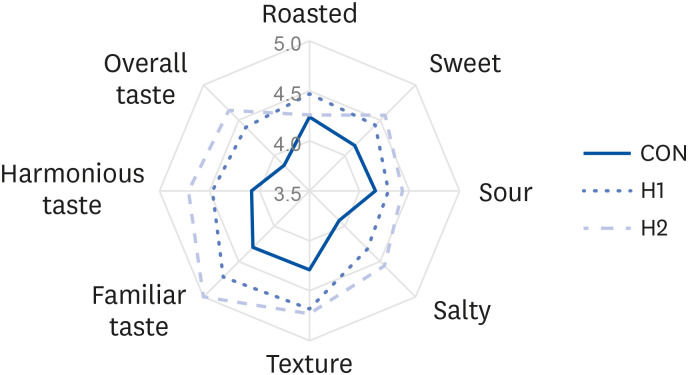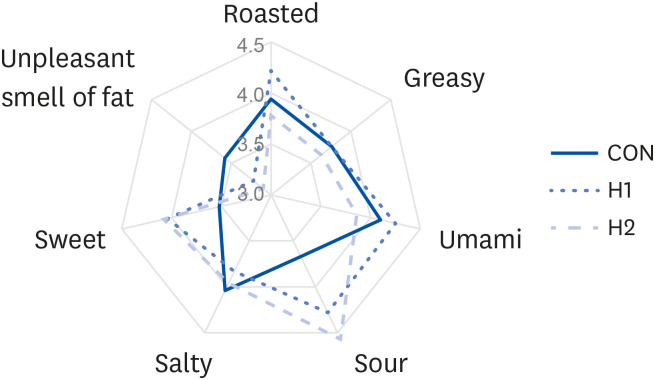Nutr Res Pract.
2022 Feb;16(1):132-146. 10.4162/nrp.2022.16.1.132.
Preference and perception of low-sodium burger
- Affiliations
-
- 1Department of Foodservice Management and Nutrition, Sangmyung University, Seoul 03016, Korea
- 2Department of Food Technology and Services, Soongeui Women's Collage, Seoul 04628, Korea
- KMID: 2525508
- DOI: http://doi.org/10.4162/nrp.2022.16.1.132
Abstract
- BACKGROUND/OBJECTIVES
Various sodium reduction policies have been implemented. However, there are limitations in the aspect of actual field applicability and efficiency. For effective sodium reduction, cooperation with the field is required and consumer preference must be considered. Thus, this study aimed to develop a low-sodium burger considering field applicability and consumer preference.
MATERIALS/METHODS
Focus group interviews and in-depth interviews on the sodium reduction measures were conducted with nine professionals in related fields to discuss practical methods for sodium reduction from September 7 to 21, 2018. By reflecting the interview results, a burger using a low-sodium sauce was developed, and preference analysis for sodium in the burger sauces and finished products was performed. The consumer preference for low-sodium burgers was evaluated on 51 college students on November 12, 2018.
RESULTS
The results of the professional interview showed that it is desirable to practice sodium reduction gradually, and by reflecting this, the burger sauce was prepared by adjusting the ratio of refined salt to 15%, 30%, and 50%. The sodium content of the burger using lowsodium sauce was 399 mg/100 g in the control group, 362 mg/100 g in the H1 group, and 351.5 mg/100 g in the H2 group, showing a 9.3–11.9% decrease in sodium in the H1 and H2 groups. The preference evaluation on the low-sodium burgers showed a higher preference for burgers with 9.3–11.9% sodium reduction, which did not affect the overall taste.
CONCLUSIONS
This study examined the potential for sodium reduction in the franchise foodservice industry. An approximate 10% sodium reduction resulted in an increase in consumer preference without affecting the strength of the taste. Thus, if applied gradually, sodium reduction at practical levels could increase the consumer preference without changing the taste or quality and could be applied in the franchise foodservice industry.
Keyword
Figure
Reference
-
1. Sacks FM, Svetkey LP, Vollmer WM, Appel LJ, Bray GA, Harsha D, Obarzanek E, Conlin PR, Miller ER 3rd, Simons-Morton DG, et al. Effects on blood pressure of reduced dietary sodium and the dietary approaches to stop hypertension (DASH) diet. N Engl J Med. 2001; 344:3–10. PMID: 11136953.
Article2. He FJ, MacGregor GA. Effect of modest salt reduction on blood pressure: a meta-analysis of randomized trials. Implications for public health. J Hum Hypertens. 2002; 16:761–770. PMID: 12444537.
Article3. Kim MY, Kim KY, Nam HM, Hong NS, Lee YM. The relationship between lifestyle and sodium intake in Korean middle-aged workers. J Korea Acad Ind Coop Soc. 2014; 15:2923–2929.
Article4. Lee MJ, Park MY, Kim JH, Sung SY, Lee MS. Impacts of high sodium intake on obesity-related gene expression. J East Asian Soc Diet Life. 2018; 28:364–374.
Article5. Cheon SY, Wang HW, Lee HJ, Hwang KM, Yoon HS, Kang YJ. Relationship of sodium consumption with obesity in Korean adults based on Korea National Health and Nutrition Examination Survey 2010–2014. J Nutr Health. 2017; 50:64–73.
Article6. Appel LJ, Frohlich ED, Hall JE, Pearson TA, Sacco RL, Seals DR, Sacks FM, Smith SC Jr, Vafiadis DK, Van Horn LV. The importance of population-wide sodium reduction as a means to prevent cardiovascular disease and stroke: a call to action from the American Heart Association. Circulation. 2011; 123:1138–1143. PMID: 21233236.7. Tsugane S. Salt, salted food intake, and risk of gastric cancer: epidemiologic evidence. Cancer Sci. 2005; 96:1–6. PMID: 15649247.
Article8. Aburto NJ, Ziolkovska A, Hooper L, Elliott P, Cappuccio FP, Meerpohl JJ. Effect of lower sodium intake on health: systematic review and meta-analyses. BMJ. 2013; 346:f1326. PMID: 23558163.
Article9. Yoon MJ, Kim YM. A study on the relationship between metabolic syndrome and sodium among the clients of the general medical examination center. J East Asian Soc Diet Life. 2018; 28:404–417.10. Kim MS, Sohn CM. Analysis of dietary inflammatory index of metabolic syndrome in Korean: Data from the Health Examinee Cohort (2012–2014). Korean J Hum Ecol. 2016; 25:823–834.11. Hwang YC, Jee JH, Oh EY, Choi YH, Lee MS, Kim KW, Lee MK. Metabolic syndrome as a predictor of cardiovascular diseases and type 2 diabetes in Koreans. Int J Cardiol. 2009; 134:313–321. PMID: 19131127.
Article12. World Health Organization. Guideline: Sodium Intake for Adults and Children. Geneva: World Health Organization;2012.13. Korea Centers for Disease Control and Prevention. Korea Health Statistics 2010: Korean National Health and Nutrition Examination Survey (KNHANES V-1). Cheongju: Korea Centers for Disease Control and Prevention;2011.14. Korea Centers for Disease Control and Prevention. Korea Health Statistics 2017: Korea National Health and Nutrition Examination Survey (KNHANES VII-2). Cheongju: Korea Centers for Disease Control and Prevention;2018.15. Ministry of Health and Welfare. The 4th National Health Plan in Korea (Health Plan 2020, 2016–2020) [Internet]. Cheongju: Ministry of Health and Welfare;2017. cited 2018 August 28. Available from: https://www.khealth.or.kr/fileDownload?titleId=29316&fileId=1&fileDownType=C.16. US Department of Health and Human Services. Draft guidance for industry: voluntary sodium reduction goals: target mean and upper bound concentrations for sodium in commercially processed, packaged, and prepared foods [Internet]. Silver Spring (MD): US Food and Drug Administration;2016. cited 2018 December 8. Available from: https://www.ncbi.nlm.nih.gov/books/NBK50951/.17. Public Health England. Salt Reduction Targets for 2017. London: Public Health England;2017.18. Health Canada. Sodium intake of Canadians in 2017. Sodium intake Canadians [Internet]. Ottawa (ON): Minister of Health;2018. cited 2018 July 23. Available from: https://www.canada.ca/en/health-canada/services/publications/food-nutrition/sodium-intake-canadians-2017.html.19. World Health Organization. Mapping salt reduction initiatives in the WHO European Region. Copenhagen: WHO Regional Office for Europe;2013.20. Hong S, Jeong H. Model Development of Nutrition Labeling on Restaurant and Fast-Food. Cheongju: Ministry of Food and Drug Safety;2007.21. Kim H. An overview of food safety and nutrition policy for children and tasks ahead. Health Welf Policy Forum. 2010; 27–36.22. Glanz K, Hewitt AM, Rudd J. Consumer behavior and nutrition education: an integrative review. J Nutr Educ. 1992; 24:267–277.
Article23. Thomas L Jr, Mills JE. Consumer knowledge and expectations of restaurant menus and their governing legislation: a qualitative assessment. J Foodserv. 2006; 17:6–22.
Article24. World Health Organization. Global Action Plan for the Prevention and Control of Noncommunicable Diseases 2013–2020. Geneva: World Health Organization;2013.25. Liem DG, Miremadi F, Zandstra EH, Keast RS. Health labelling can influence taste perception and use of table salt for reduced-sodium products. Public Health Nutr. 2012; 15:2340–2347. PMID: 22397811.
Article26. Adams SO, Maller O, Cardello AV. Consumer acceptance of foods lower in sodium. J Am Diet Assoc. 1995; 95:447–453. PMID: 7699187.
Article27. Malherbe M, Walsh CM, van der Merwe CA. Consumer acceptability and salt perception of food with a reduced sodium content. J Consum Sci. 2003; 31:12–20.
Article28. Tobin BD, O'Sullivan MG, Hamill RM, Kerry JP. Effect of varying salt and fat levels on the sensory quality of beef patties. Meat Sci. 2012; 91:460–465. PMID: 22445488.
Article29. Carvalho CB, Madrona GS, Cestari LA, Guerrero A, de Souza NE, do Prado IN. Sensory profile of beef burger with reduced sodium content. Acta Sci Technol. 2015; 37:301–305.30. Girgis S, Neal B, Prescott J, Prendergast J, Dumbrell S, Turner C, Woodward M. A one-quarter reduction in the salt content of bread can be made without detection. Eur J Clin Nutr. 2003; 57:616–620. PMID: 12700625.
Article31. Lilic S, Brankovic I, Koricanac V, Vranic D, Spalevic L, Pavlovic M, Lakicevic B. Reducing sodium chloride content in meat burgers by adding potassium chloride and onion. Procedia Food Sci. 2015; 5:164–167.
Article32. Anderson CA, Cobb LK, Miller ER 3rd, Woodward M, Hottenstein A, Chang AR, Mongraw-Chaffin M, White K, Charleston J, Tanaka T, et al. Effects of a behavioral intervention that emphasizes spices and herbs on adherence to recommended sodium intake: results of the SPICE randomized clinical trial. Am J Clin Nutr. 2015; 102:671–679. PMID: 26269371.
Article33. Mitchell M, Brunton NP, Wilkinson MG. The influence of salt taste threshold on acceptability and purchase intent of reformulated reduced sodium vegetable soups. Food Qual Prefer. 2013; 28:356–360.
Article34. de Quadros DA, de Oliveira Rocha IF, Ferreira SM, Bolini HM. Low-sodium fish burgers: sensory profile and drivers of liking. Lebensm Wiss Technol. 2015; 63:236–242.35. Willems AA, van Hout DH, Zijlstra N, Zandstra EH. Effects of salt labelling and repeated in-home consumption on long-term liking of reduced-salt soups. Public Health Nutr. 2014; 17:1130–1137. PMID: 23635386.
Article36. Bobowski N, Rendahl A, Vickers Z. A longitudinal comparison of two salt reduction strategies: acceptability of a low sodium food depends on the consumer. Food Qual Prefer. 2015; 40:270–278.
Article37. Busch J, Feunekes G, Hauer B, Den Hoed W. Salt reduction and the consumer perspective. New Food. 2010; 2:36–39.
- Full Text Links
- Actions
-
Cited
- CITED
-
- Close
- Share
- Similar articles
-
- Comparison of Sodium Reduction Practice and Estimated Sodium Intake by Salty Food Preference on Employees and Customers of Sodium Reduction Restaurant in Daegu, Korea
- Customers' Perceptions of Operational Status of and Needs for Sodium Reduction in the Industry Foodservice in Seoul
- Effect of a 6-month Low Sodium Diet on the Salt Taste Perception and Pleasantness, Blood Pressure and the Urinary Sodium Excretion in Female College Students
- Relationship between thresholds and self-assessed preference for saltiness and sodium intake in young women
- The Effect of Zinc Status on Salty Taste Acuity, Salty Taste Preference, Sodium Intake and Blood Pressure in Korean Young Adults



